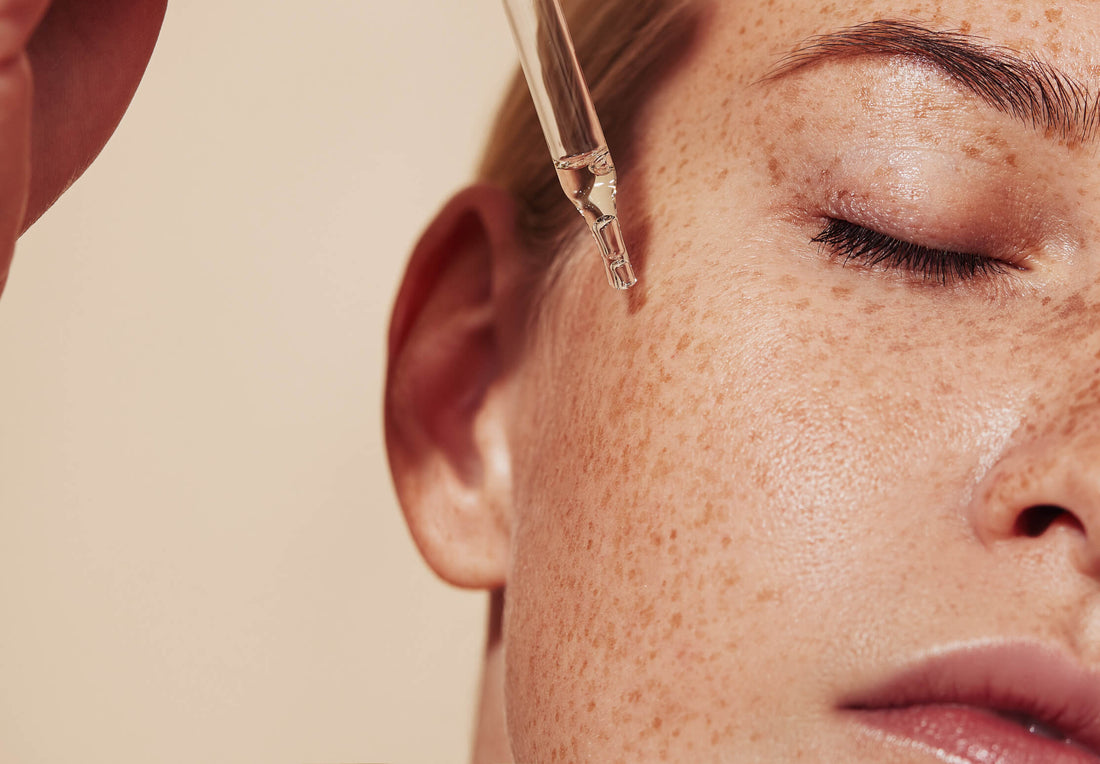
How To Layer Niacinamide and Retinol To Improve Skin Texture
Written by Dr Shamsa Kanwal - Dermatologist
Updated on March 10th 2025
Are you struggling with uneven skin texture, fine lines, or persistent breakouts? Many people resort to harsh exfoliants to achieve smoother skin, only to end up with redness and irritation. But what if there was a way to refine your skin without over-exfoliating?
Niacinamide and retinol are two ingredients known for transforming skin health. Niacinamide strengthens the skin barrier and controls oil production, while retinol stimulates cell renewal and collagen production. But when used incorrectly, these ingredients can lead to dryness or irritation.
So, can you use retinol and niacinamide together? Should one be applied before the other? And how can you integrate them into your routine without compromising your skin barrier?
This article discusses details about niacinamide and retinol, their individual benefits, and a step-by-step guide on how to layer them effectively for smooth, healthy skin.

Niacinamide And Retinol
Before discussing the best way to layer niacinamide and retinol, let’s take a closer look at what makes these two ingredients so effective.
Niacinamide: For Balance And Barrier Support
Niacinamide, also known as vitamin B3, is a multitasking water-soluble vitamin essential for maintaining skin health [1]. It plays a key role in:
-
Strengthening the skin barrier – It enhances the skin’s natural defenses, reducing sensitivity and moisture loss.
-
Regulating sebum production – It helps control excess oil, making it beneficial for acne-prone skin.
-
Reducing inflammation – It calms redness, irritation, and post-inflammatory hyperpigmentation [2].
-
Minimizing pores and improving texture – It visibly refines skin tone and smoothness.
One of niacinamide’s biggest advantages is its ability to counteract irritation caused by stronger actives, including retinol. This makes it an excellent companion for retinoids, as it helps soothe potential dryness and redness.
Retinol: For Youthful-Looking Skin
Retinol, a derivative of vitamin A, is widely recognized for its transformative effects in skincare. It works by stimulating cell turnover—shedding dead skin cells and promoting the formation of newer, healthier ones [3]. Regular use of retinol may leads to:
-
Fewer fine lines and wrinkles – It boosts collagen production, improving firmness and elasticity.
-
Refined skin texture – It smooths roughness and uneven patches.
-
Brighter, more even skin tone – It fades dark spots, sun damage, and hyperpigmentation [4].
-
Improved acne control – It prevents clogged pores and reduces breakouts.
However, retinol can cause dryness, irritation, and increased sun sensitivity, making sunscreen essential. While effective, it is often overused, especially by younger individuals who may not need its potency. It is generally more suitable for those over 45 due to its anti-aging benefits and may not be ideal for sensitive skin.
Niacinamide vs. Retinol: Which One Does Your Skin Need the Most?
Both niacinamide and retinol are sought after ingredients in skincare, but they serve different purposes. Understanding their unique benefits can help you decide which one to focus on based on your skin concerns.
When to Choose Niacinamide:
Introduce Niacinamide into your routine if you need to:
-
Balances Oil Production – Ideal for oily and acne-prone skin, niacinamide regulates sebum levels, helping to reduce shine and prevent breakouts.
-
Strengthens the Skin Barrier – Supports hydration retention and reduces sensitivity, making it a great option for those with easily irritated skin.
-
Evens Skin Tone – Helps fade dark spots, reduce redness, and improves overall skin texture.

When to Choose Retinol:
Retinol is a powerful ingredient that accelerates cell turnover, making it ideal for those looking to address skin concerns related to aging and texture. Consider using retinol if you need to:
-
Reduce Fine Lines and Wrinkles – Retinol boosts collagen production, improving skin elasticity and firmness while reducing visible signs of aging.
-
Improve Skin Texture and Tone – Regular use of retinol helps refine rough, uneven skin, smoothing out rough patches and enhancing overall skin clarity.
-
Enhance Skin Elasticity – With prolonged use, retinol strengthens the skin’s structure by stimulating fibroblasts to produce more collagen and elastin, making the skin more resilient.
However, retinol is not suitable for individuals with sensitive and younger skin due to its long-term effects. Regular use can lead to irritation, dryness, and increased skin sensitivity. Instead, we recommend gentler alternatives like hydrolyzed glycosaminoglycans and peptides that can provide similar skin-renewing benefits without the harsh side effects.
Here’s a quick comparison table highlighting the different functions of niacinamide and retinol:
| Feature | Niacinamide | Retinol |
|---|---|---|
| Key Benefit | Strengthens the skin barrier, minimizes pores, reduces inflammation | Accelerates cell turnover, smooths texture, targets fine lines & wrinkles |
| Best Suited For | Sensitive skin, redness, oily skin, enlarged pores | Acne, fine lines, wrinkles, sun damage, pigmentation |
| Potential Side Effects | Rare, mild irritation in some cases | Can cause dryness, peeling, redness, increased sun sensitivity. Not suitable for younger individuals and those with sensitive skin |
| Recommended Use | Morning & Evening | Evening Only – Avoid sunlight exposure |
| How It Works | Boosts ceramide production, reduces inflammation, improves hydration | Stimulates collagen, enhances skin renewal, increases skin elasticity |
Can You Use Retinol and Niacinamide Together?
While niacinamide and retinol can be used separately, many people wonder if they can be combined for enhanced results. The answer is yes—with the right approach, layering niacinamide and retinol can optimize their benefits while minimizing irritation.
How Niacinamide and Retinol Complement Each Other
-
Reduces Irritation – Niacinamide strengthens the skin barrier and provides anti-inflammatory benefits, helping to counteract the dryness and irritation that can come with retinol use.
-
Enhances Skin Texture and Tone – While retinol accelerates cell turnover to smooth fine lines and wrinkles, niacinamide refines pores and evens skin tone.
-
Controls Oil and Hydrates – Niacinamide regulates sebum production, which can help balance skin when using retinol, preventing excessive dryness or oiliness.
Potential Issues of Layering Niacinamide and Retinol
While both ingredients offer benefits, improper layering or overuse may cause:
-
Increased Irritation: Using high concentrations of both at once may overwhelm sensitive skin, leading to redness or dryness.
-
Barrier Compromise: Retinol can make the skin more vulnerable, and if not paired with hydrating ingredients, it may weaken the skin’s natural defenses.
-
Misuse by Younger Individuals: Retinol is a strong active ingredient that is not recommended for younger skin. Overuse can lead to sensitivity rather than benefits.
-
Overlapping Actives: Combining too many actives in one routine (such as AHAs, BHAs, and Vitamin C) with niacinamide and retinol can cause excessive exfoliation and irritation.
How to Layer Niacinamide and Retinol for Best Results
Now that we’ve explored the benefits and key considerations of niacinamide and retinol, let’s discuss how to use retinol and niacinamide together to maximize their effectiveness while minimizing irritation.
Step 1: Start with a Gentle Cleanser
Begin your nighttime routine with a mild, pH-balanced cleanser that effectively removes dirt, oil, and sunscreen without stripping the skin. Since harsh cleansers can weaken the skin barrier and heighten sensitivity to retinol, choose a hydrating formula containing Saccharide Isomerate, SyriCalm, or peachcalm to maintain moisture balance.
Even if your cleanser feels gentle, some formulas still contain ingredients that quietly clog pores or disrupt healing. Always use our pore clogging ingredient checker to verify your product is truly barrier-safe, especially when layering potent actives like retinol.
Step 2: Apply Niacinamide First for Barrier Support & Hydration
Once your skin is clean and dry, apply a niacinamide serum or toner. Since niacinamide is water-based, it should be applied before retinol for optimal absorption. Wait for 30-60 seconds to allow it to fully absorb before moving to the next step.
Looking for a niacinamide-based serum that hydrates, brightens, calms, and supports your skin barrier? Rush Hour Serum is powered by our proprietary GLOW7™ blend for gentle, multitasking results. This facial serum for sensitive skin layers perfectly under retinol while helping reduce irritation and improve tone and texture over time.
Step 3: Use Retinol to Boost Collagen & Speed Up Cell Renewal
Retinol should always be introduced gradually, especially for beginners or those with sensitive skin.
-
Start with a 0.01% to 0.03% formula before moving to higher strengths..
-
Use it only once a week initially, then gradually increase frequency as your skin adjusts.
-
Use a pea-sized amount and spread it evenly across the face, avoiding sensitive areas like the eyes, corners of the mouth, and nostrils.
Pro Tip: It’s generally advisable to avoid Retinol, as it may increase skin sensitivity, weaken the skin barrier, and heighten sun sensitivity.
Step 4: Lock in Hydration with a Moisturizer
Since retinol can be drying, follow up with a fragrance-free, hydrating moisturizer. Look for ingredients like Peachcalm, SyriCalm , and squalane to help restore the skin barrier.
Step 5: Use Sunscreen in the Morning
Retinol increases sun sensitivity, making broad-spectrum sunscreen (SPF 50) a crucial morning step. Even on cloudy days, UV rays can penetrate the skin and counteract retinol’s benefits. Apply sunscreen generously and reapply every 2 hours if exposed to sunlight.
Step 6: Pair with Gentle Ingredients
To minimize potential irritation from retinol and enhance skin barrier strength, include calming and hydrating ingredients in your routine. These help counteract dryness, redness, and sensitivity while maximizing the benefits of using niacinamide and retinol together.
-
Saccharide Isomerate – A plant-derived ingredient that deeply hydrates the skin for up to 72 hours, helping to maintain long-lasting moisture and barrier support.
-
SEPIBLISS FEEL – An active derived from coriander seeds that soothes irritation, reduces stress-induced sensitivity, and enhances overall skin comfort with a holistic wellness approach.
-
SyriCalm – A natural extract from Phragmites kharka and Poria cocos that effectively reduces redness, alleviates irritation, and restores the skin’s natural balance—ideal for stressed or sensitized skin.
Incorporating these ingredients ensures that your skin remains hydrated, resilient, and comfortable, even as you introduce powerful actives like retinol.

Step 7: Customize Based on Your Skin’s Needs
-
For Sensitive or Younger Skin:
Retinol is not recommended for individuals with sensitive skin or younger individuals due to its potential for causing dryness, peeling, redness, and increased sun sensitivity. -
For Mature Skin:
If you're over 45 and targeting fine lines, wrinkles, or loss of elasticity, retinol can be beneficial. However, a slow, strategic approach is essential to avoid over-exfoliation and irritation.
FAQs: Niacinamide & Retinol
Here are a few of the most frequently asked questions about combining niacinamide and retinol together:
-
What should not be layered with niacinamide?
Avoid using niacinamide with strong exfoliants like AHAs (glycolic, lactic acid) or BHAs (salicylic acid) in the same routine, as this may cause irritation or reduce effectiveness. If you use exfoliating acids, apply them at a different time—for example, use AHAs/BHAs at night and niacinamide in the morning. However, AHAs/BHAs are not recommended for individuals with sensitive skin.
-
Which is better for open pores: niacinamide or retinol?
Niacinamide is the better choice for minimizing the appearance of pores. It helps by:
-
Regulating oil production, which prevents pores from enlarging.
-
Strengthening the skin barrier, reducing irritation and inflammation.
-
Improving skin texture, making pores appear smaller over time.
Retinol is not recommended for addressing open pores, as it can sometimes cause dryness and irritation, making pores look more noticeable. Instead, pairing niacinamide with hydrating and soothing ingredients can refine skin texture without disrupting the barrier. Look for ingredients like:
-
Saccharide Isomerate – Provides deep hydration for up to 72 hours, keeping the skin plump and balanced.
-
SyriCalm – Reduces redness, soothes irritation, and restores the skin’s natural equilibrium.
-
SEPIBLISS FEEL – Helps calm sensitivity and enhances overall skin comfort.
Using these ingredients alongside niacinamide can help achieve smoother, more refined skin without the risk of irritation.
-
Can I use niacinamide and retinol during pregnancy?
Niacinamide is safe during pregnancy and can help with skin barrier repair and hydration. However, retinol is not recommended during pregnancy due to potential risks. Instead, consider pregnancy-safe alternatives like hydrolyzed glycosaminoglycan and peptides for anti-aging benefits.
-
How long does it take for niacinamide and retinol to show results?
-
Niacinamide: Visible improvements in skin texture, redness, and oil balance within 2-4 weeks.
-
Retinol: Noticeable reduction in fine lines, wrinkles, and hyperpigmentation within 6-12 weeks (results may vary depending on concentration and frequency of use).
-
Is it better to use retinol or niacinamide at night?
Niacinamide can be used both in the morning and at night. However, because retinol increases sun sensitivity and can cause irritation, it is best applied at night. If you choose to use both in your nighttime routine, apply niacinamide first to strengthen the skin barrier and reduce the likelihood of irritation from retinol.
That being said, if you have sensitive or younger skin, it may be best to avoid retinol altogether and opt for gentler alternatives like hydrolyzed glycosaminoglycans and peptides, which provide skin-renewing benefits without the risk of irritation.
-
How often should I use niacinamide and retinol in my routine?
Niacinamide is well-tolerated by most skin types and can be used daily, both morning and night. However, retinol should be introduced gradually. Beginners should start with once a week and slowly increase usage as tolerated, eventually reaching 2-3 times per week.
For those with sensitive or younger skin, retinol may not be the best option due to its potential for long-term sensitivity and irritation. Instead, incorporating barrier-supporting ingredients like niacinamide alongside gentler skin-renewing compounds like peptides can help improve texture and overall skin health without the drawbacks of retinol.
Conclusion
Layering niacinamide and retinol can improve skin texture, minimize pores, and address concerns like acne, fine lines, and hyperpigmentation. Niacinamide strengthens the skin barrier, reduces inflammation, and balances oil production, while retinol accelerates cell turnover and enhances skin renewal.
For best results, introduce retinol slowly, pair both ingredients with hydrating and soothing actives, and adjust usage based on your skin type. However, it’s important to consider replacing Retinol with gentler alternatives to prevent skin irritation and avoid triggering or worsening sensitivity:
If you’re unsure how to incorporate these ingredients into your routine or experience irritation, consulting a dermatologist or skincare professional can help you create a customized plan for healthy, glowing skin.

 Hydration
Hydration
 Soothing
Soothing
 Radiance
Radiance
 Clarity
Clarity









